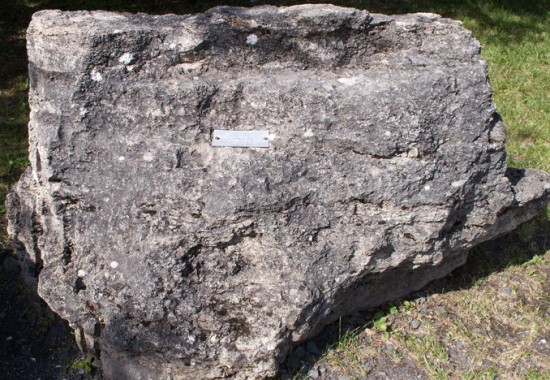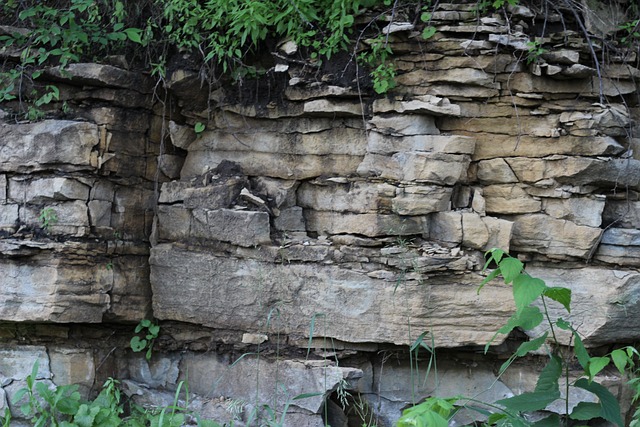When a solid rock is exposed to air, the air cuts loose tiny particles from the surface of rock. This geological process in which air wears down small fragments of rock by its continuous flow is known as weathering. Weathering disintegrates solid rock both physically and chemically and in doing so, it changes the texture (appearance) of the rock. Gravity helps these solid particles to slide along downhill (known as mass wasting). The agents of erosion like groundwater, wind or ice carry these particles to new sites where they start to build up. Next, the loose particles pile up little by little in layers on the ocean floors. These loose particles of solid rock are known as sediment. Now that as these loose particles are cemented together, they are turned into sedimentary rock. The process in which loose particles are compressed and cemented into solid rock is called lithification.
Processes of Sedimentary Rocks
Sediment
- The word ‘sediment’ comes from the Latin word sedimentum meaning ‘settling down’.
- Sediment is a general term which refers to the collection of loose solid particles separated from each other (called unconsolidated material).
- Sediment builds up in layers and has roots in preexisting rocks. It comes from different origins like:
All the solid fragments of rocks as a result of weathering and erosion;
Minerals precipitated from solutions containing chemical elements
Minerals that animals get from seawater for making of shells
Examples
Sand grains on coastline
Mud at the bottom of seawater
 Transportation | Rounding and Sorting
Transportation | Rounding and Sorting
The agents of erosion like water, wind or ice together with gravity continually change the character of sediment through a process known as weathering. They sometimes carry sediment to great distances like from Mississippi River to the Gulf of Mexico. During transportation, two processes affecting character of sediment are rounding and sorting.
Rounding
Rivers and ice transport sediment from one place to another. During the process, particles of sand and gravel rub away against each other and their jagged surfaces or edges are flattened. This process is known as rounding.
Sorting
As river water transport sediment, it tends to pick and carry specific-sized grains and leave the rest. This process is known as sorting. Since particles of bigger size weigh more than smaller ones, they are left behind. River needs to move very fast in order to transport boulders (because they require much more energy to move) as compare to pebbles. Likewise, it is easier to transport sand as compare to pebbles and so on. More river speed means more energy. Water gains speed on a steep surface but as it reduces speed like on a gentle plain, its energy decreases and begins to deposit heavier sediment first.
When grains of almost the same size cluster in the same group, the sediment is said to be well-sorted. Water (due to low viscosity) is a good sorting agent.
When different sizes of grains cluster in the same group, the sediment is said to be poorly-sorted. Glacier (due to high viscosity) is a poor sorting agent.
Sediment is deposited in the following way of descending order:
Boulders | First
Cobbles | Second
Pebbles | Third
Sand | Fourth
Silt and clay (mixture is called mud) | Last
John Day Fossil Beds National Monument in Oregon (USA) is a home of many fossils of plants and animals. These fossils date back to a period spanning between 54 million years ago and up to 6 million years ago. One of the three units of this monument is named Sheep Rock and majority of the rocks in this unit are sedimentary rocks. Here the sediment consists of mud, sand and gravel.
 Origins of Sediment
Origins of Sediment
Sediments come from two basic settings namely:
- Solid particles coming from mechanical and chemical weathering (Detrital sediment); and
- Precipitation of material through chemical weathering (chemical sediment)
Clastic (or Detrital) sediments
- Weathering of rocks occurs in two ways i.e. mechanical (physical) weathering and chemical weathering. When pieces of rock are physically broken down from its surface, it is called physical weathering. But when the minerals present in the rock are changed chemically, it is called chemical weathering.
- Weathering of rocks gives rise to particles known as clastic particles and when they are settled down after transportation, they are called clastic or detrital sediments.
- Rocks formed from these deposits are known as detrital sedimentary rocks.
Examples of clastic sediment
Boulders, cobbles, pebbles, sand, silt and clay
Chemical and biological sediments
Chemical weathering changes the mineral content of rocks and releases ions in water that are deposited in oceans and rivers. The ions and molecules are then precipitated by means of chemical or biological reactions and become chemical sediment.

Lithification | Compaction and Cementation
The conversion of loose particles of sediment into sedimentary rocks is known as lithification. It involves two important processes i.e. compaction and cementation.
Compaction
When loose solid particles reduce the empty spaces between them and fit themselves as a result of their own weight as well as weight of layers overlying them, they are said to be compacted and the process is called compaction. This way the volume of these particles decreases. The empty spaces between particles are known as pore spaces.
Example
Deposits of silt and clay contain about 80 percent water. After compaction, almost 40 percent of its weight is diminished.
Cementation
When solid particles take proper shape as a result of minerals helping them to crystallize in pore spaces and tightly held them together, cementation occurs.
Names of common cements
Calcium carbonate (CaCO3)
Silicon dioxide (SiO2)
Types of Sedimentary Rocks
Detrital or Clastic Sedimentary Rocks
- When physical and chemical weathering wears down tiny solid particles, the rocks formed out of this sediment are called detrital sedimentary rocks. Such solid particles are known as clasts. It means these rocks are formed from preexisting rocks.
- These are also known as terrigenous clastic rocks.
- About 85 percent or more of all sedimentary rocks are composed of detrital sedimentary rocks.
- The specific names of clastic sediments are assigned depending upon the sizes of different particles.
- When detrital sedimentary rocks are formed from the particles that have a size of silt and clay, they are generally termed as mudrocks. Mudrocks form 40 percent of all sedimentary rocks.
Examples of detrital sedimentary rocks
Sandstone (it is made from sand and quartz is the common mineral)
Shale
Siltstone
Chemical Sedimentary Rocks
These rocks are formed when minerals precipitate from a solution. Some organisms also contribute to the formation of chemical precipitation by secreting carbonate minerals.
Examples of chemical sedimentary rocks
The evaporation of seawater results in forming rock salt (halite)
Organisms like algae, corals release mineral called calcite (calcium carbonate). When clasts (broken particles) of seashell are cemented with calcite, limestone is formed.
Importance of Sedimentary Rocks
- These rocks are the main source of groundwater.
- Such rocks are the only source to study fossils and in this way, help geologists to study the history of living organisms.
- The primary sources of energy (fossil fuels) i.e. coal, oil, natural gas and uranium are derived from these rocks. In reality, about 50 percent of the generation of electricity in USA is produced through coal, which is a sedimentary rock.
- Majority of the ingredients used for construction are derived from these rocks like gypsum (plaster), stone, silica (glass).
Facts about Sedimentary Rocks for Kids
- About 5 percent of the rocks in the earth’s crust are made up of sedimentary rocks.
- Almost two-third area (75 percent) of the continents is covered by sedimentary rocks.
- Water is typically the agent that brings about change from sediment to sedimentary rock.
- The surface processes like physical or chemical weathering, transportation and deposition are all part of rock cycle. These processes collectively form sedimentary rocks.
- The surface processes consist of two areas of sediment. The area where solid particles are formed is called source area and the area where such sediment is deposited is called sink area.
Examples of sedimentary rocks
Coal
Limestone
Gypsum


Leave a Reply